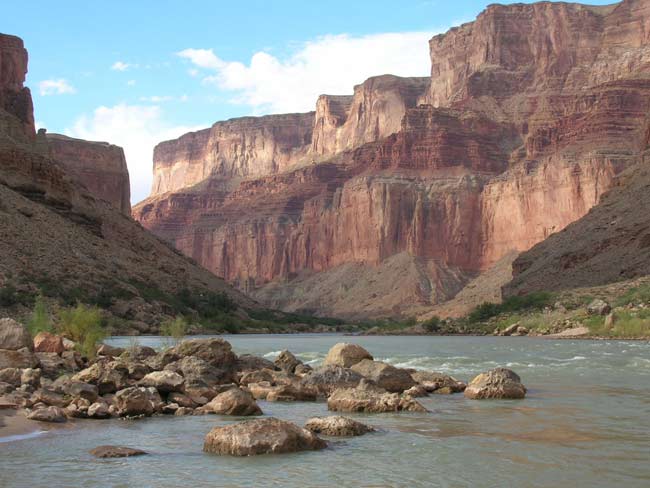Grand Canyon Possibly Old as Dinosaurs

Dinosaurs roaming the American Southwest 65 million years ago may have teetered on the edges of an ancient version of the awe-inspiring cliffs and gorges we see today in the Grand Canyon, a new study suggests. The mile-deep canyon in Arizona was formed as the Colorado River scoured through ancient rock layers millions of years ago. The most widely-posed theory of the canyon's formation is that the Colorado River connected drainages on the western slopes of the Rocky Mountains with the then newly-formed Gulf of California, incising the plateau surface to create a canyon when the plateau was uplifted. A study just last month dated the initial carving of part of the Grand Canyon at 16 to 17 million years ago, farther back in time than had been thought. Now scientists suggest pushing the date much farther back. "The Colorado River, with some help from the wind, ultimately carries the detritus away pebble by pebble, sand grain by sand grain," said one of the authors of the new study, Brian Wernicke of Caltech. "From this point of analysis, the unanswered questions about how and why the canyon formed start to pile up." Contrary to this previous theory, the new thinking, detailed in the May issue of the Geological Society of America Bulletin, indicates that the canyon, or at least a prototype of it, actually formed about 55 million years ago — and possibly sooner — in younger rock layers that lay above the ones the canyon is cut into today. Erosion wore down these layers while water continued to carve out the canyon, essentially moving the whole landscape down through the rock sequence until it got to its present-day position. Helium and heat Wernicke and his team used grains of the mineral apatite in the canyon's ancient sandstone walls to find clues as to when the different rock layers were uncovered by erosion. Apatite contains the radioactive elements uranium and thorium. As these elements decay, they spit out helium atoms. By comparing the relative abundances of the elements scientists can date the apatite grains. These crystals form deep in the Earth, where temperatures are much hotter than at the surface. (Diamond miners in South Africa who work nearly two miles underground must use elaborate air conditioning systems to battle the stifling underground heat, Wernicke noted). With each mile of depth, temperatures increase by about 72 degrees Fahrenheit (40 degrees Celsius). At temperatures above 158 F (70 C), the helium escapes from the mineral, but once the grains cool below that temperature, the helium becomes trapped. So the date of the apatite grains tells scientists the last time the rock layer was buried deep underground. Rapid erosion The dates the team got from samples taken from the bottom of the Upper Granite Gorge and the top of the surrounding plateau show that the two different rock sequences were both about 131 F (55 C) from 55 to 28 million years ago, then cooled to near-surface temperatures about 15 million years ago, Wernicke said. If the rock sequences were at the same temperature for all those millions of years, they must also have been at the same depth, Wernicke and his team surmised. This suggests to the researchers that a canyon must have existed at least 55 million years ago in the younger rock layers that once lay atop the southwestern plateaus. It might have emerged sooner, they say. "Because both canyon and plateau samples resided near the same depth since 55 million years ago, a canyon of about the same dimensions as today must have existed at least that far back, and possibly as far back as the time of the last dinosaurs at the end of the Cretaceous period 65 million years ago," Wernicke said. A rapid pulse of erosion from 28 to 15 million years ago is thought to have lowered the already-formed canyon and the surrounding plateaus from a position in the upper Mesozoic-era strata down through older rocks of the Paleozoic era — close to the position we see it at today. The finding challenges the notion that the upper layers of the rock sequence were eroded away before the canyon formed. Instead, the team's findings suggest that a canyon had formed in the upper layers and then the top rock layers were eroded away, with the river-cutting of the canyon keeping pace and continually lowering the position of the canyon.
- 101 Amazing Earth Facts
- Images: The Grand Canyon in Pictures
- The Grand Canyon's New Older Age
Sign up for the Live Science daily newsletter now
Get the world’s most fascinating discoveries delivered straight to your inbox.

Andrea Thompson is an associate editor at Scientific American, where she covers sustainability, energy and the environment. Prior to that, she was a senior writer covering climate science at Climate Central and a reporter and editor at Live Science, where she primarily covered Earth science and the environment. She holds a graduate degree in science health and environmental reporting from New York University, as well as a bachelor of science and and masters of science in atmospheric chemistry from the Georgia Institute of Technology.









